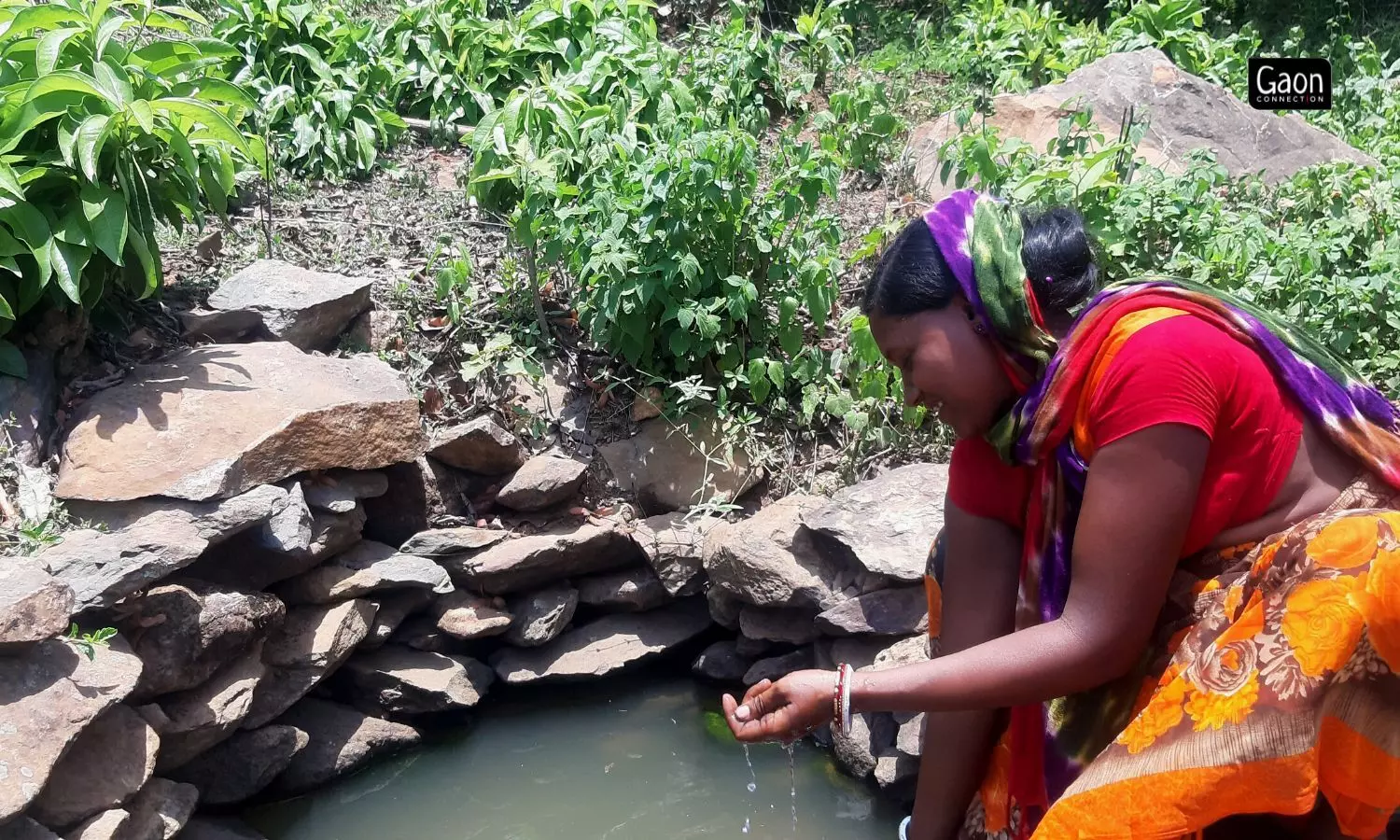Kadodiha (West Singhbhum), Jharkhand
The 35 tribal families living in Kadodiha village amidst the thick Sarandha forests in Jharkhand can finally breathe a sigh of relief. The villagers are soon expected to get safe drinking water supply by the government and will no more have to depend on the water of ‘chuas’, two to three feet deep dug out pits with water.
The district administration is working on a proposal to dig out a large, deep well at the chua site in the forest village and then with the help of a solar-based water pump, supply that water (groundwater in the dugwell from a deeper, safer aquifer) to the villagers. To begin with, such a scheme would be implemented for the primary school in the village where 21 students study.
Earlier this month, on June 13, Gaon Connection had published a ground report on Kadodiha village pointing out how all the villagers were dependent on chuas to meet all their water needs, and even the students of the Nav Prathmik Vidyalaya in the village, which was set up under the Sarva Shiksha Abhiyan in 2010, had to drink water from a chua. Their midday meal at the school was also cooked using the same water. The village is located on patta land (conditional legal right on forest plot under the Forest Rights Act) in West Singhbhum district of Jharkhand, and doesn’t even have a pucca road.
Immediately after Gaon Connection’s report, the Noamundi block administration in West Singhbhum geared into action. Public Health Engineering Department (PHED) officials visited the village on June 15 to figure out possibilities of providing safe drinking water to the village inhabitants, especially students of the Nav Prathmik Vidyalaya who, at present, depend on a chua located about 100 to 200 meters away from the school building.
The water in the chaus comes from the nearby Hurhurkocha nala. Villagers along with their cattle have been using the chua water for drinking, bathing and other purposes since the time Kadodiha came into being about three decades ago.
On June 15, Kamdev Oraon, junior engineer in PHED in Noamundi block, visited Kadodiha, located about 150 kms away from the state capital Ranchi, to investigate the matter. He acknowledged that chuas were a highly unsafe source for drinking water.
The junior engineer informed Gaon Connection that PHED had earlier drafted a proposal for installation of a deep boring facility in Kadodiha and setting up a solar-based jal minar facility in the forest village. “But it could not be implemented as there was no approach road to the forest village. Contractors expressed helplessness to work in Kadodiha as their vehicles could not reach the village,” said junior engineer Oraon.
Considering the approach-road problem, the PHED has planned an alternate method to provide safe drinking water to the villagers, he added. “We will manually dig out a big well at the chua site. With the help of a solar based water pump, we will take well water to a tank at the school campus. Safe water will be provided initially to school students through a tap connected to the tank, having a capacity of 2,000 liters,” explained Oraon.

The water in the chaus comes from the nearby Hurhurkocha nala. Villagers along with their cattle have been using the chua water for drinking, bathing and other purposes since the time Kadodiha came into being about three decades ago.
“After getting a successful result at the school campus, we will implement the same method for providing tap water to the rest of the village houses individually,” he added.
Oraon went on to inform that the PHED would send a proposal in this regard to the deputy commissioner, Ananya Mittal for approval. After getting permission, the department would start working on its mission to supply safe drinking water to the residents of Kadodiha.
Predictably, the tribal inhabitants are relieved. Amrit Bhuiya, a resident of Kadodiha, said that the Noamundi block administration was planning for an alternate source of water after Gaon Connection published a story on their water woes. “We are hopeful that soon we will get safe drinking water,” he added.
“Despite repeated requests for several years to the administrative officials and public representatives, we were unable to get safe drinking water. We had lost all hope and thought we and our children would have to drink chua water only. But after Gaon Connection published a story on our struggles, the block administration has become active,” said Bhuiya. “We are ready to work as labourers for constructing the dugwell at the chua site. We are also confident that in the near future we will get solar-based jal minar in our village,” he added.
Shanti Kandir, the cook at Nav Prathmik Vidyalaya, told Gaon Connection that parents of the students who studied in the village school were happy that soon their children will have to stop going to chua to drink water. Kandir, whose two children study at the same school, said she was relieved that she will no longer have to cook midday meals with chua water.
Devki Kumari, member of West Singhbhum Zila Parishad from Noamundi 1, said that it was unfortunate that Kadodiha and a large number of such patta-based forest villages (other than revenue and forest villages in Saranda) were still dependent on chuas for drinking water.
“I will request the deputy commissioner of West Singhbhum to approve the proposal by the department immediately. The proposal should also be implemented in other parts of Saranda to ensure safe drinking water to all such villagers,” said Devki.
Meanwhile, Sonu Sirka, social activist and former member of Manoharpur sub divisional Forest Right Welfare Committee, said that he would request the rural development department for construction of the approach road to Kadodiha and also rebuild the tin-shed school building.




















